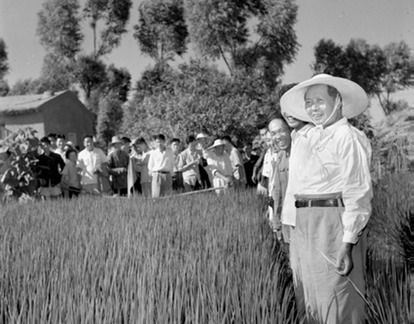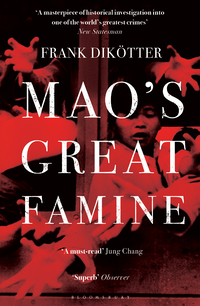Business Standard, 3 November 2010
Mao, the Grim Reaper
A recent news report says research shows that plague spread to Europe in the middle ages from China. The two great plagues of 1374 and 1665 started in China and then came all the way to Europe along the Silk Route. Similarly, the 1894 plague had its origins in China, from where it travelled to Hong Kong by land and then to the rest of the world by ship. Don’t be surprised if more such reports show up in the days to come. The inglorious past of China is a formidable counterpoint to its amazing growth over the last three decades.
The short point that Mao’s Great Famine makes is that China, the world’s largest economy after the United States, was not so long ago a bumbling dictatorship. Its economic policies were ill-conceived and badly implemented, and their consequences were almost always disastrous. People died in the millions, while Chairman Mao Zedong, surrounded by sycophants, experimented non-stop with economics. These men, like all other communists, believed in giving history a helping hand; the dire consequences did not deter them. Frank Dikotter’s book is a reminder of the mess that was China’s recent past.
The plot goes something like this. First Stalin and later Khrushchev were obsessed with making the Union of Soviet Socialist Republics a bigger economy than the United States of America. So long as Stalin was there, Mao was the lesser communist. On his visits to Moscow, Mao was treated shabbily by Stalin. Once Stalin died and Khrushchev took over, the tables were turned. Mao held the new leader in contempt — he even met Khrushchev dressed in a pair of swimming trunks.
It was now the turn of the Chinese to turn the heat on Moscow. Mao knew that China was vital for Moscow to contain the growing influence of the USA in the region, so he could dictate terms. In this game of one-upmanship, Mao announced that in 15 years China would overtake the United Kingdom.
China’s natural advantage was land, large tracts of arable fields. If the farm output could somehow be raised, China could barter the surplus with other communist countries and even the West for machines, technology et al. This was the “Great Leap Forward”. Dams were constructed across mainland China with forced labour. Since these were done in a hurry, the designs were often faulty. The sluice gates wouldn’t open during floods, the tunnels silted with concrete in no time. Far from checking floods and improving irrigation, this worsened the situation of the farmers.
Mao next turned his attention to cultivation habits. Peasants for generations, he found, had planted rice saplings at some distance to each other. Yields would improve, he argued, if these were planted closer. The decision was carried to the remotest corner of the large country. Again, the results were disastrous. The crop began to fail. Sycophants transplanted paddy to fields along the roads so that Mao and his lieutenants could see how well their ideas were working.
Cowsheds and houses made of mud, the same people argued, could become a good source of manure. These were thus brought down and the mud was spread on the fields. Whether it worked or not is not known; what is certain is that it made millions homeless. Those who resisted when their houses got bulldozed were called enemies of the state and suitably punished.
While farm output did not grow, Beijing’s commitment to exports was on the rise. The produce was often substandard, but still the state pressed on with the shipments. The result was a huge shortage of food within the country. It was a man-made famine. Dikotter’s conclusion is somewhat similar to Amartya Sen’s about the Bengal famine of the early-1940s.
Sen found that the famine was caused not just by a shortfall in foodgrain production but also the inability of the imperial government to rush supplies to the province. Britain, and hence all its colonies including India, was in the midst of the Second World War. All rail and road transport was commandeered to help the war effort, which included rushing troops to the border with Burma (now Myanmar) to check the advance of the Japanese. Nothing could be spared for the poor people of Bengal who died in the millions.
When it became clear that there wasn’t enough grain for Beijing to buy steel mills abroad and ship them to China, Mao came up with another ingenious idea: why not encourage people to run small smelters in their backyards? Steel, after all, was what modern economies were built on. These smelters were fired by wood and melted all steel implements — tools, pots and pans — that could be found in the household.
Naturally, the steel was of a very poor quality. It was another experiment that failed miserably, but not before it had caused a lot of pain and anguish to ordinary Chinese people.
Wasn’t there any voice of dissent? Dikotter says that Mao had an overbearing personality. Most of his close associates, including Zhou Enlai, lived in dire fear of him. They were often asked to criticise themselves in public for even harbouring a thought against the policies of Mao. And they did so willingly; after all, their survival was at stake.
But not everybody was like that. There were people who objected to the way Mao planned the Great Leap Forward. Such voices were few in number. More often than not, Mao found it convenient to smother these few voices of dissent.
It is noteworthy that most of the information in the book has been culled from correspondence and official notes of the era, which have been opened up for research by the Chinese government. Maybe it shows that the follies of those days no longer embarrass the country. You could put that down to its economic turnaround. Prosperity can obliterate the worst sins.

